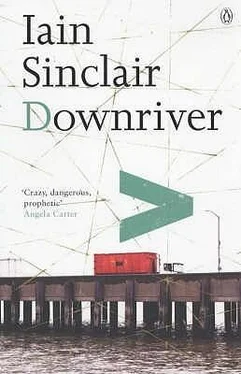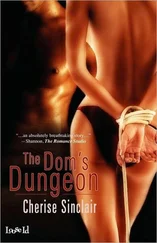The ‘newcomers’ fade into frenzy, and emerge in other disguises. Excesses of poverty and privation, outlandish sacrifices, draw the prying eyes of the ‘concerned’ world (Baroness Coutts, Mr Dickens, Dr Barnado, James Hinton): pull down a few tenements, start a soup kitchen, grant exilic status to disgraced politicians (a nice reversal, now they flee to Whitechapel to get away from whores!). Rodinsky’s room is untouched, immune. It is the absolute still centre of the maze; walls of furious wind break around it. It is preserved by the uncaring velocity of the street business that surrounds and disguises it. It is safe because — until now — it is unmentioned.
The man himself was out of history, so calm, so unwilling to announce his presence by any sudden movement, that it was safe to cry: he is gone! We were rushing too fast, too much taken with the ‘importance’ of the mystery. If we enter, and publicly expose this chamber of silence, shame will surely follow us, tearing everything apart. The walls of the labyrinth will tumble out like a tract of virgin rain forest.
Fredrik was amused by the pretensions of my argument; but well able to trump me. He had received that morning a package sent on by the curator at Princelet Street, documents gathered in response to his Spitalfields essay in The London Review of Books .
The first item, given in evidence, was a paper-clipped pair of photographs of Rodinsky’s room, taken from almost identical positions: one, just after the vanishing act — and the second, within the last year, to illustrate Fredrik’s article. The contrast was astonishing. The abandoned room of the 1960s is neat and sparely furnished: no sign of the books, and romantic clutter. On the wall, where there is now an empty wooden frame, was once a large-scale reproduction of the ‘Angelus’. The calendar, repeating the image, hung closer to the bed. The tide of time, with the passing decades, has washed all the gash — the diaries, bottles, pans, suits — back from the void. The uninhabited set has been deluged with artefacts that attempt to reconstruct a deleted personality. What has happened, inexplicably, is that each visitor has been compelled to leave something behind. The room, as we are now presented with it, is entirely staged: it is as unreal as the shadowland Hermann Warm painted for Das Kabinett des Dr Caligari .
Next, there was a letter, headed ‘A Mystery Solved’, photocopied from the Jewish Chronicle of 24 June 1988.
As a boy in the late 1930s David Rodinsky was ‘boarded out’ with my mother and father, who were Jewish Board of Guardians foster parents.
Many years later, around 1967, I came across him again in the course of my work as a JWB social worker, and by then he was living at the synagogue.
More recently the room was ‘discovered’ with his books and personal effects left untouched, as though he had just walked out. Rabbi Hugo Gryn asked me if I could shed some light on his background, and I searched for the JWB file which I knew went back to about 1930, but unfortunately it had been destroyed.
Incidentally, he did not disappear; he died of a stroke when he was in his mid-forties.
Michael Jimack,
Research and Information Officer,
Federation of Jewish Family Services.
‘ Unfortunately it had been destroyed !’ Fredrik snorted, and caressed his wart, ‘exactly what they told me about the Princelet Street collection, “lost in transit, can’t be located at this time”. Do you imagine that Simon Wiesenthal ever “destroyed” a file? It’s unheard of, yes? These people will hunt a rogue spoor through the centuries, through any wilderness of shredded documents: there is no place on earth to hide from them. They’re still hot on the trail of the descendants of the pogrom-initiators, and the blood-crazed racist fanatics from the time of the crusades.’
Fredrik was so excited that he began to juggle a cat and a child, switching them — to the delight of the infant and the horror of the animal — from hand to hand, in a manic version of ‘find-the-lady’. ‘No, listen, it won’t wash: something is seriously out of synch. The affair takes on the gristle-plasma texture of Kennedy Assassination paranoia: the shift where, suddenly, everything is true. And worse. These genealogical “dicks” are deliberately keeping the lid on, burying Rodinsky as an atypical incident. They’ve stamped the trunk: “Do Not Open Until the Millennium.” They don’t want any Second Coming.’
Now, with a flourish, Fredrik passed me the final item, another letter, written by hand, to Michael Jimack, responding to his note in the Jewish Chronicle . These sheets of lined paper remain the only surviving human report on Rodinsky and his family. As I read them I felt the temperature change: the natural and immediate tone of voice dropped me into a tale that Dostoevsky never got around to completing.
4.7.88
Stoke Newington
Dear Mr Jimack
Having read your letter about David Rodinsky, I am prompted to write to you, which is now a matter of history.
I am the last surviving son-in-law of the late Myer Reback, who was shamash of the Princelet Synagogue, & I married his daughter (now deceased) in 1937.
I was no stranger to the Rodinsky family & knew them well. They occupied a two-roomed flat above the living rooms of the late Mr and Mrs Myer Reback, & I made a few visits to them.
There was the mother a widow, & she had two children, a girl named Bessie, who unfortunately was mentally backward, spending most of her life at Clayberry Mental hospital. Her visits were very rare to Princelet Street & there was David, the son, who always looked pasty-faced & the flat was always like a ‘hagdesh’. The mother was not over-bright, she was toothless, & always walked about with a blanket over her shoulders. Please forgive me, but I gave her the name of‘Ghandi’, & by that name she is still mentioned by the Reback family to this day. Her life was full of worry for the future, & the Reback family helped her in various ways, under her poor circumstances; all in all, the mother & son lived like hermits on the top-floor flat above the synagogue. Now about David: he was not bright in his youth, his complexion was very sallow, something about him in his speech was rather hesitant in conversation. My daughter Lorna (who is 49) knew him quite well & remembers him, as she spent many hours at her grandfather & grandmother’s flat when she was quite young.
In 1939, I was called up to serve in the RAMC through the military hospital reserve, & having seen service in the Middle East, India & Burma, I returned to England (a trained nurse) in 1946, & my connection with the synagogue was history. It was in 1948, while working at the German Hospital in Dalston as a male nurse, I attended a bar mitzvah at the Heneage Street Synagogue, & to my surprise I met David, he was there for the Kiddush!
He recognized me immediately, in the few years of my absence he had grown taller, more manly, & very coherent. He still lived at № 19 Princelet Street, & to my surprise he was quite fluent speaking Arabic. This came about when I told him of the many places I had visited, & could converse to him in Arabic, as I had seen service at the Suez Canal & Cairo. This was my last meeting with him, & this ends my story.
Princelet Street has a history of well-known personages. Next door the synagogue, Miriam Moses’ father had his sweatshop for tailors; the story is that he obtained his employees from the immigrants of 1890, by going to the London docks, & getting men who spoke no English & paying them 1 gold sovereign for 6 days’ work, the hours were 6 a.m. to 12 p.m. at which time he turned off the gas light! ‘Jewey Cook’, the boxer, lived in a tenement next door, & he would sit on the doorstep displaying his Lonsdale Belt with pride. His real name was Cohen, his father was a retired Polish tailor, who was well known to the Polish tailors of the West End, where he could be found begging in his old age. ‘Jewey Cook’s’ cousin is married to Vera Lynn, he is a trumpeter & bandleader, original name of Cohen, but has anglicized it. The last I knew of ‘Jewey Cook’ was 1936, he told me he worked as a labourer in a travelling circus. There is a large house, no doubt having belonged a Huguenot silk weaver, immediately opposite the synagogue. Here lived the Rev. Yellin, the mohel; there may be circumcision certificates still around.
Читать дальше












